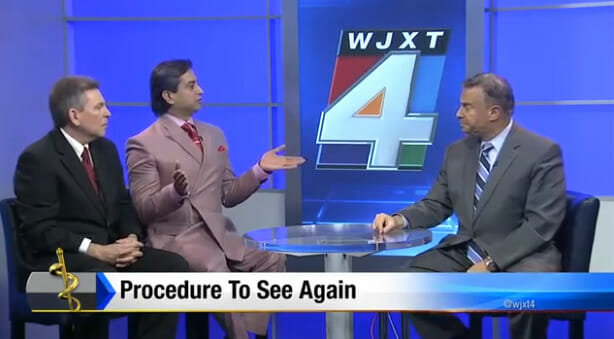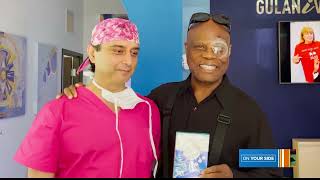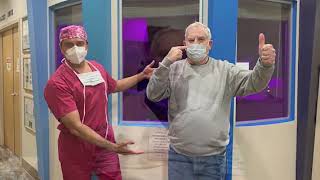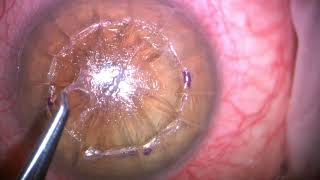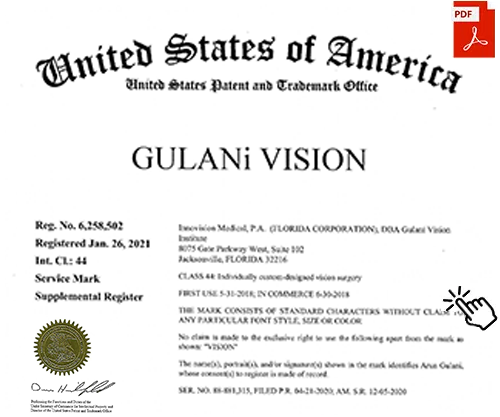Vision Architect
m”iVision”: GulaniVision
Gulani Vision notice the “i” in the GulaniVision purposefully italicized to symbolize the individuality factor with which Dr. Gulani plans, performs and executes vision to each individual eye. Though Gulani Vision has become a commonly used term by our patients worldwide expressing their experience and unparalleled vision outcomes at our practice, it embodies custom-designed vision surgical plans to take each patient to their best vision potential.
Dr. Gulani is widely known as the Vision Guru ™ by patients, eye surgeons and the eye care industry due to his unparalleled track record of successful outcomes, besides his wide range of experience over 3 decades, not only for his ability to diagnose and easily understand some of the most complex and complicated cases that are referred to him from around the world, but also for his unmatched surgical finesse and award-winning innovations.
This title of The Vision Guru™ further underscores his passion to teach and inspire eye surgeons as only a “Guru” can.
Combining his dual gifts as a vision Architect and Artist, he conceptualizes and custom designs eye surgery for each patient individually and then executes at a level that raises the bar in the world of eye surgery
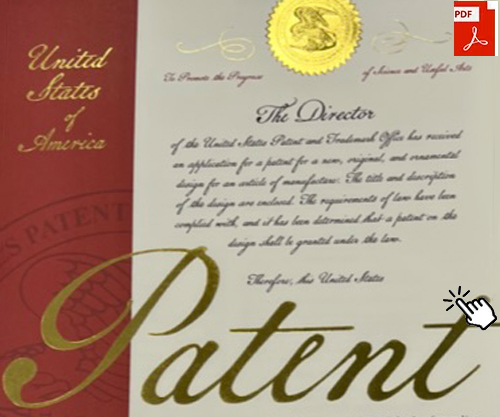
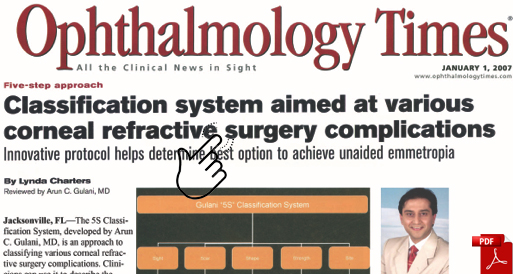
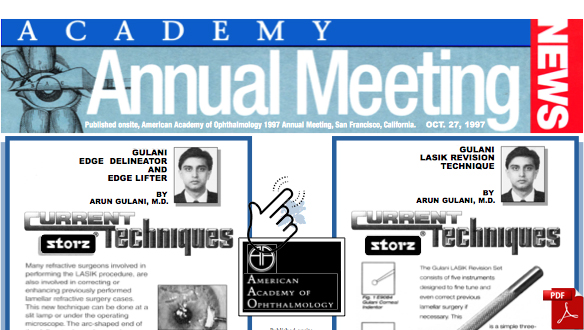
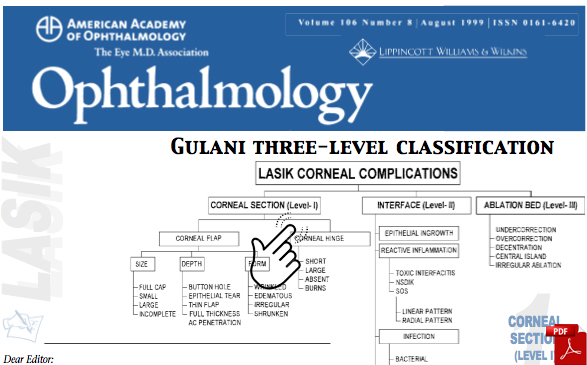
Architect

“A combination of DaVinci and Michelangelo, not only can he envision the future he actually can create it.” – Joe, Spain
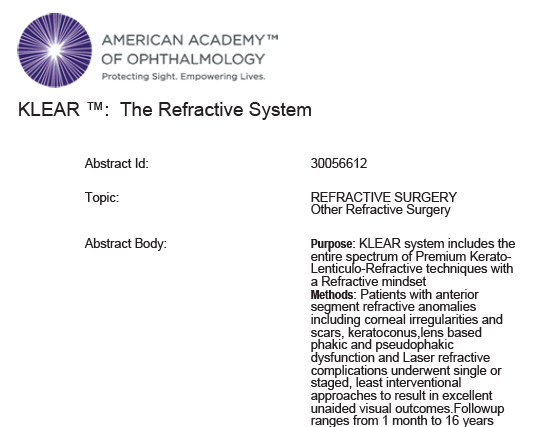
Like an architect Dr. Gulani first studies your eye: the anatomy, physiology, optics, and vision potential including the landscape of associated pathologies, complexities, or previous surgical complications. Combining this intense knowledge with advanced technology diagnostics he lays the design for a vision surgical plan. This individualized vision architectural plan (miVision) along with his proprietary GPS™ becomes a signature blueprint for each patient’s surgical plan. He then uniquely applies specific techniques and cutting-edge technology, KLEARTM, (wide range of nearly 40 surgical techniques and technologies) to execute with surgical finesse to deliver that vision by design or in some complex cases to correct the foundation, and then deliver the vision.
Surgical Instruments

In his quest to control every element of design, leaving very little to chance, Dr. Gulani has even designed award-winning surgical instruments that allow him to execute his delicate surgical skills like an artist.
On a lighter note Dr. Gulani’s penchant for perfection lead him to him designing our Institute and Surgical Suite and of course this passion is reflected in his own designed suits and surgical scrubs. Our Surgical Suite houses the World’s First Cataract SPA and is Registered Trademarked by the US Patent and Trademark Office.
Protocols
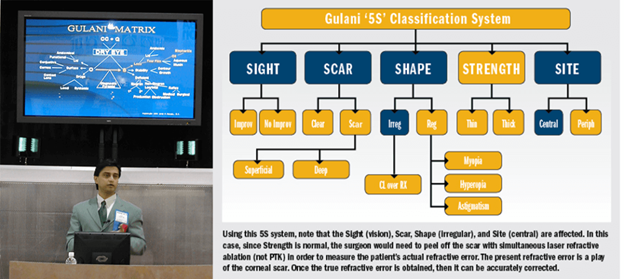
With three decades of experience of having designed for thousands of patients worldwide and delivered their best vision, Dr. Gulani has even created proprietary protocols ranging from advanced technology diagnostics to unique surgical application including combinations to address each patient’s unique visual landscape. He shares these protocols selflessly while teaching surgeons and advising industry globally.
The backbone of Dr. Gulani’s visual architectural plan is Dr. Gulani’s 5S System that can not only address simple cases but also breakdown complex and complicated cases to a lucid blueprint for vision surgery.

Gulani Vision À La Carte

Vision à la carte is a concept Dr. Gulani would like to share with all ophthalmic surgeons wherein they can design vision for each patient individually, using all of today’s technologies and techniques, including combinations of these.
The cornerstone of success is the surgeon’s ability to customize their approach to each patient’s vision goal or best vision potential (BVP).
How do we arrange these techniques and pick the ones most suitable for each patient?
Dr. Gulani approach has always been that we eye surgeons are all vision corrective surgeons (irrespective of cornea, LASIK, or cataract specialties).
In this armamentarium of vision corrective surgery—think of it as an umbrella term with about 40 techniques, i.e., there are nearly 20 different types of LASIK/laser vision surgery (10 now, with the recent SMILE technique Dr. Gulani performed while abroad), 4 types of implantable lenses, 8 techniques of Cataract surgery, over 30 approved premium lens implants, 7 types of corneal transplants, 5 types of intrastromal corneal ring segments, and about 3 ways of doing collagen cross linking, etc.
Combinations For Customization
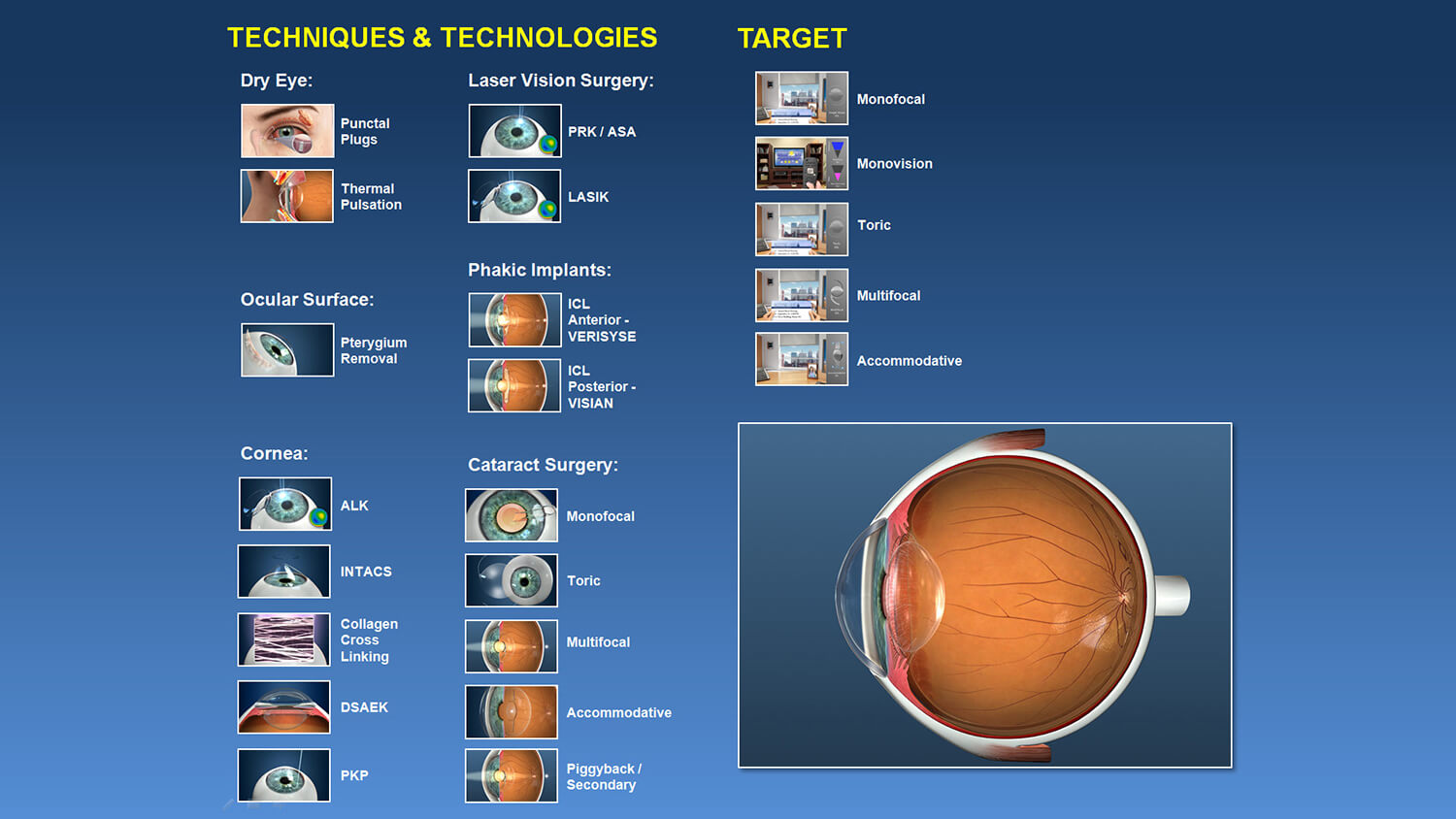
The combinations and permutations therefore exceed over a hundered. With these approaches at your fingertips, Dr. Gulani urges surgeons to use various combinations and have unlimited permutations to tailor to each patient’s vision goal (Gulani AC: Designer Vision Surgery: BOA conference, Mumbai, 2013).
Dr. Gulani likes to teach this to surgeons and patients as “Lego™ pieces”. He suggests arranging these surgery techniques like Lego™ pieces on shelves in your mind. Each category should have its own color. For example, all laser vision techniques could be blue, all cataract surgery lens implant choices and techniques yellow, all corneal techniques green, adjunct techniques such as collagen cross linking (that can be used in combination with practically any surgery) white. Now, say you are planning a combination of cataract surgery (yellow piece) with LASIK (blue piece). You now have a plan that can be visualized, and the colors can be used to explain your plan so much more easily. This approach also empowers you to pick whatever piece is best suited for the patient or even choose combinations. This concept can be applied to complex and complicated cases. For example, in the case of a LASIK ectasia, you can plan for lamellar corneal transplant (a green piece), followed by laser PRK (a blue piece) 6 months later. This needs to be followed by collagen cross linking (a white piece).
Customization further involves the proper consideration of three factors that Dr. Gulani calls the “3T’s”: target, technique, and technology.
Target. A specific target is a very important piece that Dr. Gualni believes was missing from vision corrective surgery until the past few years. Surgeons performed surgeries and hoped for the best (or at least what they thought would be good for patients). Today, we need to plan for specific vision targets. If the patient is a pilot, he wants a certain vision at different illuminations (i.e., day and night). If he is a golfer, he wants certain vision at specific distances and often at multiple points. A dental surgeon or an architect’s desire for near vision is usually arms’ length, not 16 inches. We are now making our surgery accountable like never before. Set the target vision with patient counseling and education and work backwards to pick the technology and technique to achieve that. This is in synch with patient expectations today.
Technique. Really raising the bar on surgery to an ART, techniques have always been as varied as the surgeons performing them. Today, it means more than individual variances based on training and comfort. Technique now implies how we size, shape, and plan depth for LASIK flaps; Smile LASIK concepts; incisions in cataract surgery; planning for the shape, size and centration of capsulorrhexis; flip/crack/chop and other modifications of cataract consumption; or corneal endothelial transplants in the form of DSAEK/DMEK, etc.
Technology. Technology in diagnostics provide us with information about nooks and crannies of the human eye we did not even know existed previously leaving us with little excuse to what I call “Leaving Vision on the Table.” Study of vision impact factors besides refractive errors including spherical aberration and wave fronts, allows us to aim for our choice of the specific technology in surgery so we can address all adversely affecting vision factors (like aiming for a strike in bowling, and not just settling for a spare.
Understanding the Universally Applicable System:

The Gulani 5S Classification System algorithm sets the background to my approach and makes any simple or complex case scenario lucid enough to understand and effectively treat.
This algorithm involves classification according to sight, scar, shape, strength, and site.
- Sight: If the patient has potential vision, we as eye surgeons need to get to work.
- Scar: Is the cornea scarred or clear? If scarred, we need to modify the scar in the interest of vision.
- Shape: All laser vision surgery is based on shape. We flatten myopia, steepen hyperopia, and turn a football-shaped astigmatic cornea into a spherical basketball.
- Strength: Is the cornea tectonically strong (i.e., of a normal thickness)? Is it thicker (Fuchs’ dystrophy, epikeratophakia)? Is it thinner (LASIK ectasia, keratoconus)? The surgeon must remove additional tissue, such as in a case of epikeratophakia in a thick cornea, or add a lamellar corneal transplant in a case of ectasia.
- Site: Peripheral corneal problems are not as visually significant as central problems, unless they indirectly affect vision, such as with induced astigmatism.
You can address any virgin or complex case with a simplified understanding of the 5S system and a plan that not only you and your patient can understand but they can email this plan to their friends and families as well (Eyemaginations, Inc., Baltimore, MD, is working with Dr. Gulani towards developing this 3D software prototype).

The Time Is Now
Today, with patient expectations, available technology options, and information resources, patients are literally coming in with their own vision goals, chosen technology, and researched techniques for the surgeon to perform.
With a global patient clientele our my practice, Dr. Gulani is seeing patients every day who are willing to travel to a surgeon they have chosen, in their minds, to be the most capable to deliver their “Individualized Vision Goal.”
This concept may serve to relieve you of constantly being under the gun of oncoming technology promises coupled with prohibitive expenses and will not necessitate re-learning techniques and challenging your comfort zone.
Instead, this concept allows you to use all the surgical techniques you already have access to and are capable of performing and put them into a new perspective.
Additionally, this concept of planning with patients invigorates them to the fact that you are personalizing a plan in their best interests, and therefore, they become your teammate and choice of the 3Ts then becomes a welcome pleasure as opposed to a confabulating trade off towards choice for patients.
Patients are moving from the “burgers for everyone” concept and are asking for “à la carte” treatments. Are you ready to offer a menu of vision corrective options?
To Prepare and Repair:

This unique skill of designing and performing along with experience in a wide range of surgeries and technologies allows Dr. Gulani to prepare an eye which may be “Not a Candidate” for candidacy as well as to repair eyes that are referred to him following surgical complications. For example, he may prepare an eye with an INTAC ring to proceed with candidacy for LaZrPlastique or he could repair a LASIK complication eye with Laser CorneoPlastique to remove the scar and prepare the eye for premium Cataract Surgery.
iVision Individually Designed

So do not settle for “cookie-cutter” or routine surgeries. Ask for miVision plan and insist that your eye surgeon individually designs for your best vision potential which is the hallmark of GulaniVision.


